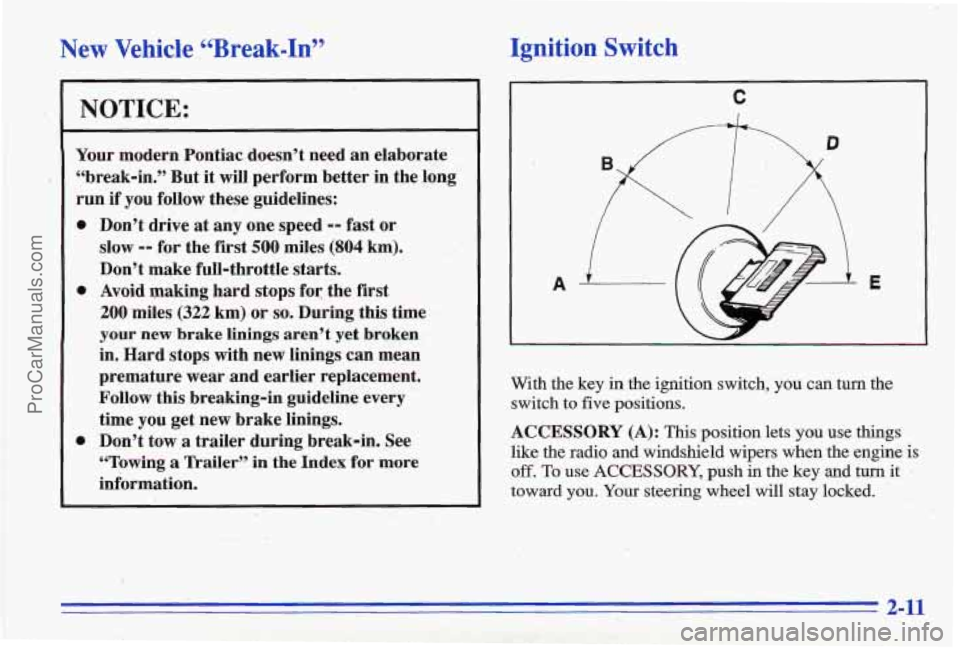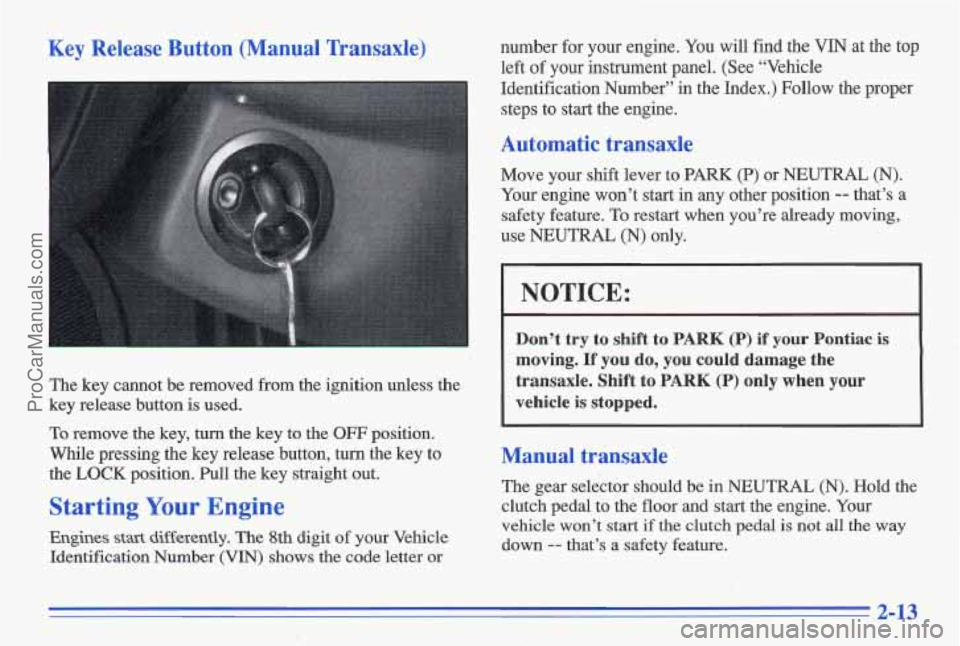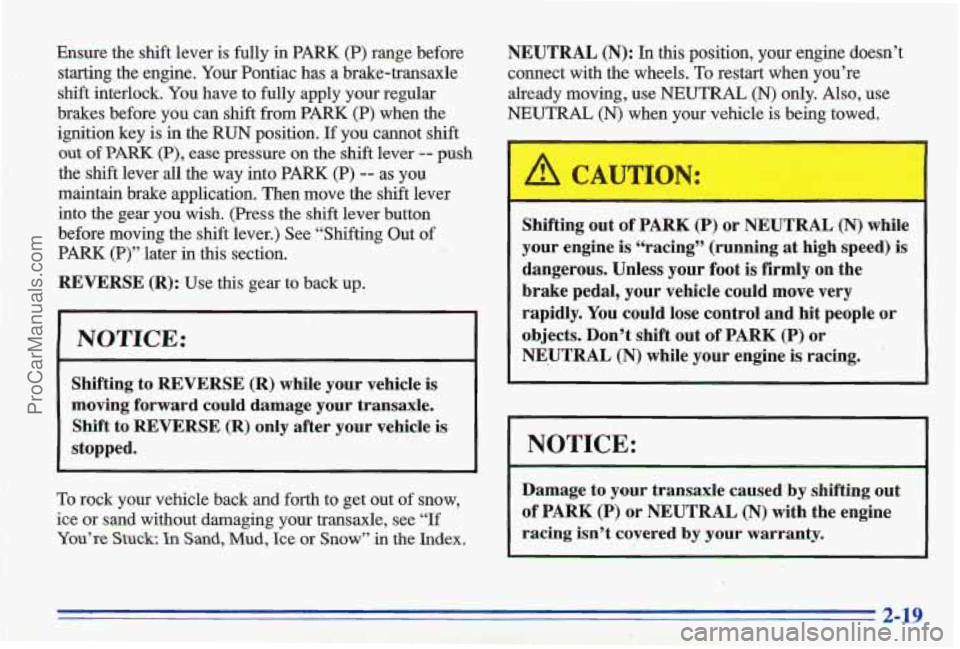1996 PONTIAC GRAND-AM lock
[x] Cancel search: lockPage 64 of 356

Trunk Trunk Lock
4 CAUTION: ..
It can be dangerous to drive with the trunk lid
open because carbon monoxide
(CO) gas can
come into your vehicle. You can’t see or smell
CO. It can cause unconsciousness and even death.
If you must drive with the trunk lid open or if
electrical wiring or other cable connections must
pass through the seal between the body and the
trunk’ lid:
Make sure all windows are shut.
0 lbrn the fan on your h’eating or cooling
system to its highest speed with the setting
on VENT. That will force outside air into
your vehicle.
See “Comfort Controls’’ in the
Index.
instrument panel,
open them all the way.
If you have ai: outlets on or under the
See “Engine Exhaust” in the Index.
To unlock the trunk from the outside, insert one of the
keys to the vehicle and turn the trunk
lock cylinder.
Remote Trunk Release
The remote trunk release handle is located on the floor
near the left side of the driver’s seat in front of the fuel
door release. Pull upward on the remote release handle
to release the
trunk lid. Make sure the override feature is
not activated.
2-8
ProCarManuals.com
Page 65 of 356

Trunk Security Override
The remote trunk release is
equipped with an override
feature to help prevent
unauthorized entry into the
trunk when leaving the
vehicle unattended. The
switch is located on the
inside
of the trunk lid,
mounted to the trunk lid
latch.
To turn the override feature on, slide the switch all the
way to the right.
To turn the override. feature off, slide
the switch all the way to the left.
When the override is on, the mechanical remote trunk
release will not release the trunk lid. However, the
trunk
lid can still be opened with the key.
This lockout feature is only available on vehicles that do
not have the Keyless Entry System.
Theft
Vehicle theft is big business, especially in some cities.
Although your Pontiac has
a number of theft-deterrent
features, we know that nothing we put on it can make it
impossible to steal. However, there
are ways you can
help.
Key in the Ignition
If you leave your vehicle with the keys inside, it’s an
easy target for joy riders or professional thieves -- so
don’t do it.
When you park your Pontiac and open the driver’s door, you’ll hear
a chime reminding you to remove your key
from the ignition and take it with you. Always do this.
Your steering wheel will be locked, and
so will your
ignition.
If you have an automatic transaxle, taking your
key out also locks your transaxle.
And remember to lock
the doors.
Parking at Night
Park in a lighted spot, close all windows and lock your
vehicle. Remember to keep your valuables out
of sight.
Put them in a storage area, or take them with you.
2-9
ProCarManuals.com
Page 66 of 356

If you par^ in a lot where someone will be wawung
your vehicle, it’s best to lock it
up and take your keys.
But what if you have to leave
your ignition key? What if
you have to leave something valuable. in your vehicle?
Put your valuables in a storage area, lie your trunk
Lock the glove box,
Lock all the doors except the driver’s.
or
glove
box,
e Then take the door key with you.
Passlock TM
Your venicle 1s equipped with the Passlock
theft-deterrent system.
Passlock
is a passive theft-deterrent system. The system
,is armed once the key is‘removed from the ignition.
Passlock enables fuel if the ignition lock cylinder is
turned
with a valid key. If a correct key is not used, fuel
is disabled.
During
normal operation, the THEFT SYS light will go
off after the engine is started. In the unlikely event that
the engine stalls and the THEFT SYS light flashes, wait
until the light stops flashing b’efose
trying to restart the
engine. Remember to release the key
from the START
position as soon as the engine starts. If after several tries
the vehicle still does
not start, the vehicle may need
service. At this time, you may
also want to check the
fuses (see “Fuses and Circuit Breakers” in the Index).
See your Pontiac dealer for service.
If the THEFT SYS light comes on while the engine is
running, a problem
has been detected and the system
may need service. See your dealer for service.
In an emergency, call the Bontiac Roadsi4e Assistance
Program at 1-8OO-RBADSIDE or 1-800-762-3743.
ProCarManuals.com
Page 67 of 356

New Vehicle.“Break-In” Ignition
Switch
NOTICE:
Your modern Pontiac doesn’t need an elaborate
“break-in.” But it will perform better in the long
run if you follow these guidelines:
0
0
0 Don’t drive at any one speed -- fast or
slow
-- for the first 500 miles (804 km).
Don’t make.ful1-throttle starts.
Avoid making hard stops
for the first
200 miles (322 km) or so. During this time
your new brake linings aren’t yet broken
in. Hard stops with new linings can mean
premature wear .and earlier replacement.
Follow
this breaking-in guideline every
time you get new brake linings.
Don’t tow
a trailer during break-in. See
“Towing
a Trailer” in the Index for more
information.
C
A E
W
With the key in the ignition switch, you can turn the
switch
to five positions.
ACCESSORY (A): This position lets you use things
like the radio and windshield wipers when the engine is
off. To use ACCESSORY, push in the key and turn it
toward
you. Your steering wheel will stay locked.
..
ProCarManuals.com
Page 68 of 356

LOCK (B): Before you pur: the key into the ignition
switch, the switch is
in LOCK. It’s also the only position
in which you can remove the key. This locks your
steering wheel, ignition and transaxle
(on automatic
models).
OFF (C): This position unlocks the steering wheel,
ignition,
and transaxle (on automatic models), but does
not send electrical power to any accessories. Use this
position
if your vehicle must be pushed or towed, but
never
try to push-start your vehicle. A warning chime
will sound if you open the driver’s
door when the
ignition
is off and the key is in the ignition. 1
RUN (D): This position is where the key returns after
you
start your engine and release the switch. The switch
stays
in the RUN position when the engine is running.
But even when the engine
is not running, you can use
RUN to operate your electrical power accessories, and
to display
some instrument panel warning lights.
START (E): This position starts your engine. When the
engine
starts, release the key. The ignition switch will
return
to RUN for normal driving.
Note that even if the engine is not running, the positions
ACCESSORY and RUN are on positions that allow you
to operate your electrical accessories, such as the radio. On manual transaxle
vehicles, turning the key to
LOCK will lock the steering column and result in
a loss of ability to steer the vehicle. This could
cause
a collision. If you need to turn the engine
off while the vehicle is moving, turn the key only
to
OFF. Don’t press the key release button while
the vehicle is moving.
NOTICE:
If your key seems stuck in LOCK and you can’t
turn it,
be sure it is all the way in. If it is, then
turn the steering wheel
left and right while you
turn the key hard. But turn the key only with
your hand. Using a tool to force it could break
the key or the ignition switch. If none of this
works, then your vehicle needs service.
2-12
ProCarManuals.com
Page 69 of 356

Key Release Button (Manual Transaxle)
The key cannot be removed from the ignition unless the
key release button is used.
To remove the key, turn the key to the
OFF position.
While pressing the key release button, tufn the key to
the
LOCK position. Pull the key straight out.
Starting Your Engine
Engines stast differently. The 8th digit of your Vehicle
Identification Number
(VIN) shows the code letter or number for your engine.
You will find
the VIN at the top
left of your instrument panel. (See “Vehicle
Identification Number” in the Index.) Follow the proper
steps to start the engine.
Automatic transaxle
Move your shift lever to PARK (P) or NEUTRAL (N).
Your engine won’t start in any other position
-- that’s a
safety feature. To restart when you’re already moving,
use NEUTRAL
(N) only.
NOTICE:
Don’t try to shift to PARK (P) if your Pontiac is
moving.
If you do, you could damage the
transaxle. Shift to
PARK (P) only when your
vehicle is
stopped.
Manual transaxle
The gear selector should be in NEUTRAL (N). Hold the
clutch pedal to the floor and start the engine. Your
vehicle won’t
stat? if the clutch pedal is not all the way
down
-- that’s a safety feature.
2-13
ProCarManuals.com
Page 74 of 356

Automatic Transaxle Operation
Your Grand Am may be.equipped with a four-speed
automatic transaxle. The shift lever
is located on the
console between the seats. i
P
R
N
ID1
3
2
1
There are seven different
positions
for the shift lever
on the four-speed
autom&ic transaxle.
PARK (P): This locks your front wheels. It’s the best
position to use when you start your engine because your
vehicle can’t move easily.
It is dangerous to get out of your vehicle if the
shift lever
is not fully in PARK (P) with the
parking brake firmly set. Your vehicle can roll.
Don’t leave your vehicle when the engine is
running unless you have to, If you have left the
engine running, the vehicle can move suddenly.
You or others could be injured. To be sure your
vehicle.won’t move, even when
you’re on fairly
level ground, always set your parking brake and
move the shift lever to PARK (P).
See &‘Shifting Into PARK,(P)” in the Index, Tf
you’re pulling a trailer, see “Towing a in
the Index.
2- 18
ProCarManuals.com
Page 75 of 356

I
Ensure the shift lever is fully in PARK (P) range before
1 ’. I . starting the engine. Your Pontiac has a brake-transaxle !’ 2 . shift interlock. You have to fully apply your regular
brakes before you can shift from PARK (P) when the
ignition key is in the
RUN position. If you cannot shift
out of PARK (P), ease pressure on the shift lever -- push
the shift lever all the way into PARK
(P) -- as you
maintain brake application. Then move the shift lever
into the gear you wish. (Press the shift lever button
before moving the shift lever.) See “Shifting Out
of
PARK (I?)” later in this section.
REVERSE (R):
Use this gear to back up.
NOTICE:
Shifting to REVERSE (R) while your vehicle is
moving forward could damage
your transaxle.
Shift to REVERSE (R) only after your vehicle
is
stopped.
To rock your vehicle back and forth to get out of snow,
ice or sand without damaging your transaxle, see
“If
You’re Stuck: In Sand, Mud, Ice or Snow” in the Index. NEUTRAL
(N):
In this position, your engine doesn’t
connect with the wheels.
To restart when you’re
already moving, use
NEUTRAL (N) only. Also, use
NEUTRAL (N) when your vehicle is being towed.
I
Shifting out of PARK (P) or NEUTRAL (N) while
your engine
is “racing” (running at high speed) is
dangerous. Unless your foot is firmly on. the
brake pedal, your vehicle could move very
rapidly.
You could lose control and hit people or
objects. Don’t shift out of PARK
(P) or
NEUTRAL
(N) while your engine is racing. .
NOTICE:
Damage to your transaxle caused’by shifting ‘out
of PARK
(P) or NEUTRAL (N) with the engine
racing isn’t covered
by your warranty.
ProCarManuals.com